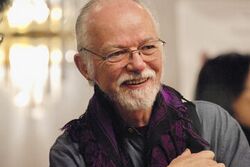Biography:John Kenneth Salisbury, Jr
J. Kenneth Salisbury, Jr. | |
|---|---|
 | |
| Born | July 12, 1951 Schenectady, New York, USA |
| Academic background | |
| Alma mater | Stanford University |
| Academic work | |
| Institutions | |
| Main interests |
|
John Kenneth Salisbury, Jr. (born July 12, 1951, in Schenectady, New York) is an American Roboticist and Research Professor Emeritus at Stanford University’s Computer Science Department and Stanford School of Medicine’s Department of Surgery. Salisbury is a researcher in the fields of robotics, haptics, and medical robotics.[1] He is an inventor of over 50 patents[2][3] and recipient of the 2011 IEEE Inaba Award for "Commercialization of Products in Medical Robotics, Robotics, and Haptics".[4]
Academic background
Kenneth Salisbury received his Bachelor of Science (1975), Master of Science (1977), and PhD (1982) at Stanford University. His PhD thesis, Kinematic and Force Analysis of Articulated Hands was advised by Professor Bernard Roth. He is an academic descendant of the Father of Modern Kinematics, Ferdinand Freudenstein.[5]
From 1982 through 1997, Salisbury served as Principal Research Scientist at the Massachusetts Institute of Technology’s Artificial Intelligence Laboratory. From 1997 through 2003, he was Fellow and Scientific Advisor at Intuitive Surgical in Mountain View, CA. He joined the faculty at Stanford in 1999 where his research has focused on the design of robots for interaction with and near humans as well as haptics and surgical simulation. He became Professor Emeritus in 2017.
Work
Salisbury's work is organized around the following topics:
- Robot Hands:multi-finger hand mechanisms, control systems and perception techniques[6]
- Haptics: interfaces and rendering techniques[7]
- Robot Arms:force controllable robotic arms [8]
- Personal Robotics: robots to work near and with humans, HRI[9]
- Medical Robotics: user interfaces and surgical simulation[10]
Selected references
- Salisbury, J.K., Jr. (1999). Making graphics physically tangible. Communications of the ACM (Vol. 42, Number 8), pp. 74–81.
- Salisbury, J.K., Jr. & Craig, J. J. (1982). Articulated Hands: Force Control and Kinematic Issues. International Journal of Robotics Research, 1(1). Massachusetts Institute of Technology.
- Mason, M.T. and J.K. Salisbury, Robot Hands and the Mechanics of Manipulation, M.I.T. Press, Cambridge, MA, 1985
Awards
- IEEE Inaba Technical Award for Innovation Leading to Production for Feb 2011, Contributions to Commercialization of Products in Medical Robotics, Robotics and Haptics.[4]
References
- ↑ "J Kenneth Salisbury, Jr. Professor (Research) Of Computer Science And of Surgery (Anatomy), Emeritus". stanford.edu. https://profiles.stanford.edu/john-salisbury.
- ↑ "Patents by Inventor J. Kenneth Salisbury, Jr.". patents.justia.com. https://patents.justia.com/inventor/j-kenneth-salisbury-jr?page=3.
- ↑ "Master having redundant degrees of freedom". patents.google.com. https://patents.google.com/patent/US6684129B2/en.
- ↑ 4.0 4.1 "IEEE Inaba Technical Award for Innovation Leading to Production". ieee-ras.org. https://www.ieee-ras.org/awards-recognition/society-awards/69-awards-recognition/society-awards/59-ieee-inaba-technical-award-for-innovation-leading-to-production.
- ↑ "J. Kenneth Salisbury, Ph.D.". web.stanford.edu. https://web.stanford.edu/group/sailsbury_robotx/cgi-bin/salisbury_lab/?page_id=1217.
- ↑ The Salisbury Hand is part of the National Museum of American History's collection of robots and other automatic machinery from industry, research, fantasy, and entertainment.”
- ↑ Massie, T.H. & Salisbury, Jr., K. (2009). Force Reflecting Haptic Interface. US Patent No.7480600 B2.
- ↑ Townsend W.T. & Salisbury J.K., Jr. (1993). Mechanical Design for Whole-Arm Manipulation. In: Dario P., Sandini G., Aebischer P. (eds) Robots and Biological Systems: Towards a New Bionics? NATO ASI Series (Series F:Computer and Systems Sciences), vol 102. Springer, Berlin, Heidelberg.
- ↑ Wyrobek, K., Berger, E., Van der Loos,H.F.M., & Salisbury, K. (2008) Towards a Personal Robotics Development Platform: Rationale and Design of an Intrinsically Safe Personal Robot. IEEE ICRA, May 19–23, 2008.]
- ↑ High-fidelity haptic and visual rendering for patient-specific simulation of temporal bone surgery. Chan, S., Li, P., Locketz, G., Salisbury, K., & Blevins, N. H. (2016). Computer Assisted Surgery, 21(1), 85¡V101

